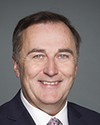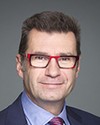Thank you, Mr. Chairman.
Good afternoon, everyone. It's a pleasure to be here.
The Vanier Institute of the Family is a national, independent, charitable organization dedicated to understanding the diversity and complexity of families and the reality of family life in Canada.
We're a national resource for anyone who is interested in or involved in families in Canada.
For those of you who aren't familiar with the institute, we were established by General The Right Honourable Georges P. Vanier and his wife Pauline, 50 years ago. Their Excellencies established the institute to study all families in Canada. Since Monsieur Vanier was a husband and a father as well as an officer, a wounded vet, and a commander-in-chief, we honour his legacy in our military and veteran family initiative.
At the institute, we seek to understand families and to enhance the national understanding of how families interact with and have an impact on our social, economic, environmental, and cultural forces.
We fulfill that mission through our research, our publications, our projects, our presentations, partnerships and collaborations, and of course, these days, through networks and social media.
I'm here today to share with you information about the military and veteran family initiative. I'm here to share insights from our round tables with vets and veteran organizations, families, and family support organizations. I'm here to inspire those who study, serve, and support families, to engage with and include military and veteran families in all of their programs and services across the country.
First, here's a little bit about the military veteran family initiative. About five years ago, following a round table that I had the honour to co-host with the current Governor General, the Right Honourable David Johnston, and his wife Sharon, we brought together a group of family experts from across the country, one of whom was a military representative. Of all the distinguished people at the round table, everybody knew a little bit about every aspect of family. Everybody knew a little bit about refugee families, indigenous families, and families new to Canada, and so on. Nobody around the table had a solid understanding of military or veteran families. These were the cream of the crop of Canadian experts and they were not aware of what military and veteran families were experiencing. We followed that with a series of round tables and, ultimately, a conference on military and veteran families, and we solidified this initiative.
The purpose of the initiative is to increase awareness of military and veteran families, their unique experiences, their perspectives, and what they bring to the table; and to bring together those who serve exclusively, or largely, military and veteran families with those organizations that may be serving military and veteran families and not even know it.
We have four primary goals in the initiative, namely to build awareness, to build professional competency, to build organizational capacity, and to build community. Regardless of where military and veteran families live—and we know they are in every community from coast to coast—should they reach out to access any service, whether it be education, health, mental health, or recreation, everybody will have at least a basic understanding of their experiences and their perspectives, so that they'll be able to access equitable services, regardless of what community they live in.
Our ultimate goal is to ensure that those families have equitable access to services in the communities in which they live.
In that past five years, we have been working specifically on building awareness by increasing military literacy. We want every community service provider, every teacher, principal, guidance counsellor, and mental health provider to have at least a basic understanding of military and veteran families—the lingo, the jargon—and to help them understand the reality of their experiences.
We have been working with organizations to build organizational capacity, so that organizations as a whole can begin to identify, recognize, and support military and veteran families.
We have been working on building professional competency, whether it's within the field of early childhood education, or teaching, or mental health.
We're about to launch a new awareness program specifically targeting building awareness for family physicians across the country. That will be launched in November of this year in British Columbia.
We're building community. We want every professional and every organization to know who in their community and who within their peer group is available to assist them when necessary. When a family, a veteran, or a military family goes to reach out for services or support, they are received and immediately start to get what they're looking for as opposed to being put in a paused state, or being referred to somebody else and having to wait for a longer period of time. Everybody will be able to meet their needs.
One of the major accomplishments of the military veteran family initiative has been the establishment of the Canadian military and veteran leadership circle. This was established almost two years ago, and it now includes 35 member organizations from the private, public, and non-profit sector. As you would imagine, some of the military and veteran organizations, like the legion and the organizations that serve veterans, are members.
What's unique about this particular leadership circle is that it also includes organizations like the Canadian Child Care Federation. We know that when a military family has a new child, like other families in Canada, they're likely going to be reaching out and accessing child care services in their community. We're working with organizations like that to make sure they have basic awareness and understanding of the life of a military and veteran family.
We held the inaugural, first of its kind, meeting in 2015, and began to develop and establish collaborations, co-operations, and partnerships across and among organizations. One of the major outcomes has been to reduce duplication and to increase proper collaborations, so that if a family is participating in one program and slides over to another, then it's a seamless move. We've seen organizations pool their resources so that they're better together than they are separately.
The leadership circle was co-founded and co-chaired by the chief of military personnel.. When he left it was taken over by the commander of military personnel command, the deputy minister of VAC, and the chair of the Vanier Institute.
Our purpose of the leadership circle is to strengthen the community of support for Canadian military and veterans' families through knowledge mobilization, relationship building, and coordination of existing services, emerging projects, and programs. What we're looking at is ensuring that the programs that are evolving and developing are evidence based, evidence informed, or evidence inspired. We're linking the research that's being done, the academic research, and the program evaluation research together to make sure what is being made available is of high quality and is based on evidence.
What we're doing now is leveraging the skills, talents, and expertise of the key community leaders, and we're continuing to build awareness, capacity, competency, and community.
As we begin to work together, we want people to understand the experiences of veterans' families and the life they've had while being in the military and in transition. We want the professional community across the country to have an understanding of the mobility, separation, and risk that military families have experienced, and what veterans are going through in transition.
We believe that we can accomplish more together and that we can extend our reach by working together. VAC and government don't have to do this alone. We are working across organizations to eliminate boundaries, to build a bigger picture, and to mobilize community support across the country.
Our members are passionate and diverse. We continue to discover interconnections and interdependencies among stakeholders and service providers, as well as family members. It's about relationships. It's about how we look forward to helping these relationships grow.
In addition to organizations like VETS and other organizations, we have wonderful advancements being made with school guidance counsellors in rehabilitation and integration, and with occupational therapists and physiotherapists across the country.
One of the things the leadership circle has produced is a compendium, which is a perpetual digital document. It is a summary to date of all of the partnerships and collaborations that are in existence across the country, and it is growing continually. The next meeting is this January, and we'll continue to see that grow.
It's our pleasure to be here and to work with you as you continue your work. We continue to work with those organizations that have shared interests and shared mandates, including those around the world in the United States, in Australia, and in the U.K.
We are a resource to you and to other organizations in Canada. We invite you to work with us as we continue to pursue our mandate and our objective to ensure that military and veterans' families have access to the services they need.
Thank you.




